Pvc pipes for plumbing: features, standards, installation
How good is a PVC piping pipe against competing solutions? By what standards are these products manufactured? What ways can pipes be connected? Let's try to answer these questions.
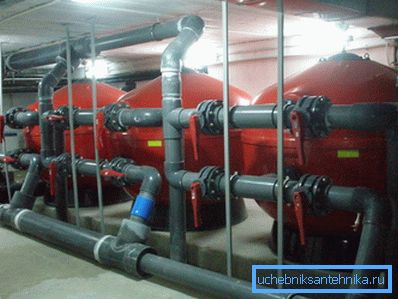
Advantages and disadvantages
To begin, let's try to evaluate the material. Its use in laying sewer networks has already become the standard; is it worth to opt for PVC water?
Merits
- Resistance to corrosion distinguishes PVC from black steel. However, all polymers can boast the same.
- Lifetime estimated to be foggy 50 years or more.. In general, the chemical stability of plastics has become the main reason for its use in waste systems, so that this estimate can be believed.
- The dielectric properties of the polymer mean both a lower probability of electric shock during wiring faults, and the absence of electrochemical processes., arising, for example, in the presence of copper and aluminum in one water supply system.
- From the main direct competitor - polyethylene - PVC is distinguished by a slightly higher ring stiffness with the same wall thickness..
In addition: polyethylene is combustible, and polyvinyl chloride does not support combustion.
disadvantages
- The limited range of operating temperatures. Long-term temperature should not be higher than +45 C; let's say a short-term heating up to +65 C. If so, you can forget about the use of PVC on hot water or heating.
- At low temperatures plastic becomes brittle. Water freezing in the pipe will surely cause its rupture - unlike polyethylene, which in this case will only slightly stretch, and after defrosting will return to its original size.
- Although plastic does not sustain combustion, when heated to more than 120 degrees, it begins to decompose with the release of toxic and suffocating hydrogen chloride.
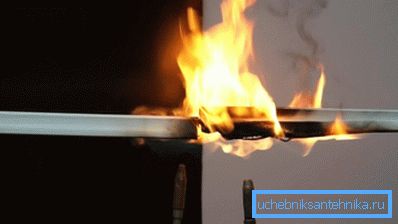
From the point of view of the author, on the background of polyethylene (especially cross-linked) and polypropylene, PVC looks unattractive.
Regulations
The main technical characteristics of PVC pipes for water supply are regulated by two standards.
- GOST R 51613-2000 contains requirements for pressure pipes of unplasticized polyvinyl chloride;
- GOST R 52134-2003 describes pressure pipes from thermoplastics in general; PVC-U is also mentioned in the list of materials (also known as PVC-U).
Let's take a quick look at the text of the documents.
GOST R 51613-2000
The dimensions of PVC pipes for plumbing should comply with the following table:
| Outer diameter, mm | Wall thickness, mm at operating pressure, MPa | |||||
| 0.5 | 0.63 | 0.8 | 1.0 | 1.25 | 1.6 | |
| ten | 1.5 | |||||
| 12 | 1.5 | |||||
| sixteen | 1.5 | |||||
| 20 | 1.5 | |||||
| 25 | 1.5 | 1.9 | ||||
| 32 | 1.6 | 1.9 | 2.4 | |||
| 40 | 1.5 | 1.6 | 1.9 | 2.4 | 3.0 | |
| 50 | 1.6 | 2.0 | 2.4 | 3.0 | 3.7 | |
| 63 | 1.6 | 2.0 | 2.5 | 3.0 | 3.8 | 4.7 |
| 75 | 1.9 | 2.3 | 2.9 | 3.6 | 4.5 | 5.6 |
| 90 | 2.2 | 2.8 | 3.5 | 4.3 | 5.4 | 6.7 |
| 110 | 2.7 | 3.4 | 4.2 | 5.3 | 6,6 | 8.1 |
| 125 | 3.1 | 3.9 | 4.8 | 6.0 | 7.4 | 9.2 |
| 140 | 3.5 | 4.3 | 5.4 | 6.7 | 8.3 | 10.3 |
| 160 | 4.0 | 4.9 | 6.2 | 7.7 | 9.5 | 11.8 |
| 180 | 4.4 | 5.5 | 6.9 | 8.6 | 10.7 | 13.3 |
| 200 | 4.9 | 6.2 | 7.7 | 9.6 | 11.9 | 14.7 |
| 225 | 5.5 | 6.9 | 8.6 | 10.8 | 13.4 | 16.6 |
| 250 | 6.2 | 7.7 | 9.6 | 11.9 | 14.8 | 18.4 |
| 280 | 6.9 | 8.6 | 10.7 | 13.4 | 16.6 | 20.6 |
| 315 | 7.7 | 9.7 | 12.1 | 15.0 | 18.7 | 23.2 |
Pipes can be supplied with sockets for gluing and rubber sealing ring.
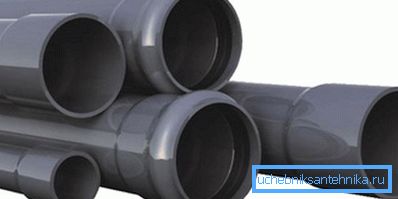
Curiously, the word gluing does not quite accurately describe the mechanism of the process. The surfaces to be joined are treated with a volatile compound that dissolves polyvinyl chloride; after evaporation of the solvent, the plastic molecules of the two parts intermingled with each other provide a strong and tight connection.
The length of straight segments can be from 4 to 12 meters.
GOST R 52134-2003
The study of the second standard will bring us an unexpected discovery: according to its text, the maximum pipe diameter can be 630 millimeters with a maximum wall thickness of 61 mm.
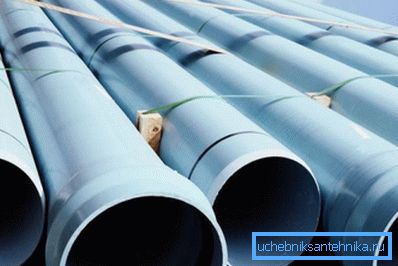
We note another interesting point: the standard, among other things, describes the procedure for testing pipes under pressure. NPVH must withstand 60 degrees for 1000 hours, which gives an idea of the actual strength of the material.
Cost of
In order for the reader to have the opportunity to compare the retail price of PVC pipes with alternatives, we will quote several prices for products sold on the Russian market under the Dyka brand.
| Diameter, mm | Wall thickness mm | Price, euro / linear meter |
| 20 | 1.5 | 1.28 |
| 25 | 1.9 | 2.23 |
| 32 | 2.4 | 2.61 |
| 40 | 3.0 | 4.04 |
| 50 | 3.7 | 6.18 |
| 75 | 4.5 | 11.46 |
| 110 | 6,6 | 24.44 |
Installation
How to assemble a plumbing water supply line from your own home?
Assembly on rubber seals requires no special comments. The subtlety is only one: when connected with a bell, the pipe cut at the place of the pipe should be removed from the outer chamfer.
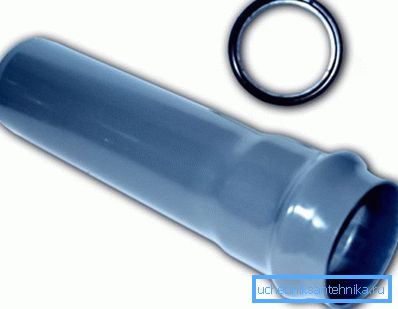
The instructions for connecting to glue are a bit more complicated.
- Ensure compatibility of parts to be joined. The pipe should without obstacles enter the bell to 2/3 of its depth.
Tip: for cutting pipes in size it is better to use a special cutter, somewhat reminiscent of a garden pruner. In this case, the cut will be perfectly flat and strictly perpendicular to the longitudinal axis.
- Remove the chamfer from the pipe.
- Blow and wipe the surfaces to be bonded.
- Defat the surface with methylene chloride. It will not only remove dirt, but also partially dissolve the surface of the plastic.
- Apply glue to the outer surface of the pipe as evenly as possible using a brush with a width of 3-4 centimeters.
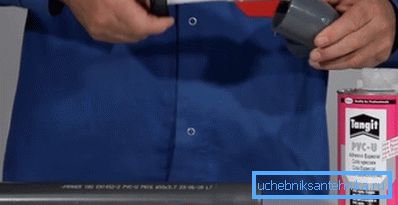
- Insert it tightly into the socket and rotate 90 degrees. Thus, you evenly distribute the adhesive inside the socket.
- Fix both parts in a fixed position for 1-2 minutes. The final stabilization of the pipe connection will take several hours.
Conclusion
We hope that our material was quite informative and allowed the reader to evaluate PVC as a material for water supply. The video in this article, as usual, will offer additional thematic information. Successes!